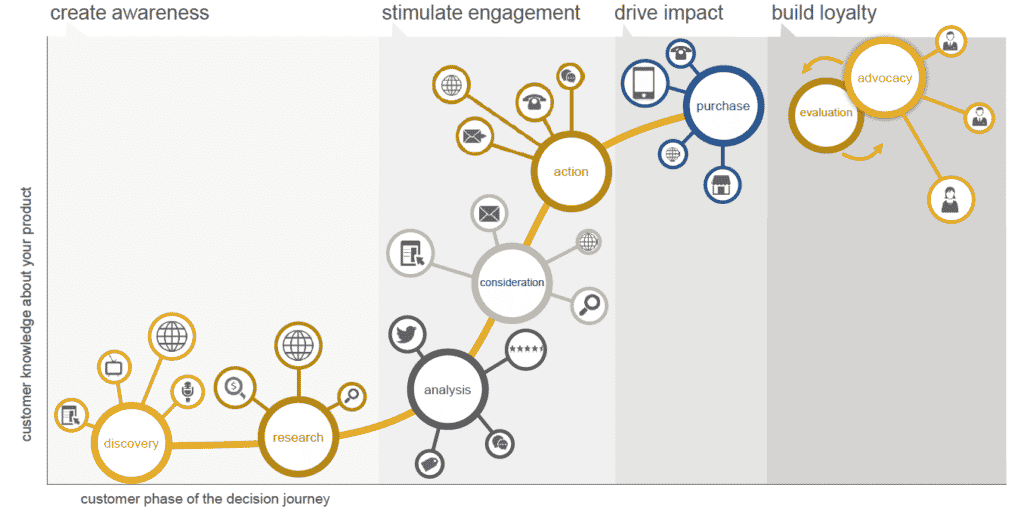For marketers, there are few things as important as appropriately understanding your customers’ decision journey. It is the collection of actions, events, or moments that lead to conversion. And, as a consequence, it is an absolute necessity to properly attribute success to the correct touchpoint or touchpoints that influence decision making. That’s why it’s so important for marketings to adopt a marketing attribution model.
A marketing attribution model offers clarity into the optimal and most efficient path and the combination of events needed to trigger a specific behavior. It can help marketers assess which tactics to invest in, which strategies succeeded or failed, and which channel (if any) is more valuable than the rest. On a more micro level, attribution modeling can even help marketers determine if a single, specific ad is helping to drive conversions.
Ultimately, there are a plethora of different models (though, really, three major categories), with each being slightly different in its outcome and design.
MARKETING ATTRIBUTION MODEL CATEGORIES
SINGLE SOURCE ATTRIBUTION
Just as the name implies, Single Source Attribution gives full credit to one touchpoint along the converting path. Usually, it’s either First Click or Last Click. So, should you use the First Click methodology, you’re ascribing credit to the first piece of media or touchpoint that brought a visitor to your site. Conversely, for Last Click, it’s assigning credit to the final touchpoint that led to a conversion.
The problem with Single Source Attribution is that the models within this category are considered to be far too simplistic, and widely recognized as inaccurate when compared to some of the more sophisticated measurement techniques. What’s more, with so many touchpoints on the journey (see first graphic), it doesn’t make sense to attribute all of the conversion to either the first or the last contact.
FRACTIONAL ATTRIBUTION
Fractional Attribution is significantly different in that each touchpoint is given distinct attribution weights (or, in the case of equal weighted attribution, equal weight). With this approach, there ends up being a number of wholly unique models.
Some of these include Weigh Last, Weigh First, U-Shaped, V-Shaped, Equal Attribution Models. They’re all slightly different; however, to some extent, it’s a matter of personal preference and what you think best represents accurate attribution for the goals of your web analytics strategy.
ALGORITHMIC ATTRIBUTION
Finally, Algorithmic Attribution uses data science to analyze patterns within converting paths to determine optimal conversion credit for each touchpoint. It’s usually a much more sophisticated approach, taking into account business specific priorities and approaches within the customer journey.
ALIGHT’S APPROACH TO THE MARKETING ATTRIBUTION MODEL
At Alight, we’ve got our own suite of attribution models, each falling within one of the aforementioned categories. However, they are unique in that we’ve built into each model a twist that makes them more holistic in their ability to communicate attribution.
ONLINE CHANNEL CONVERSIONS
With this model, we’re moving away from the outdated First and Last Click methodology. Online Channel Conversion offers a far more comprehensive approach that works by mining through your website data to observe those channels that are contributing to conversions. You can find out what paths are working and why.
ONLINE CHANNEL OPTIMIZATION
Online Channel Optimization is a bit different than the previous model, as it collects all web visits, allowing you to see the relationship between online engagement and conversions.
ONLINE CHANNEL PERFORMANCE
Knowing what works is great, but sometimes it’s just as important to know what isn’t. The Online Channel Performance model works by aggregating all website visits, splitting them into converting and non-converting paths. By segregating and categorizing the data, you can determine if your users are utilizing your marketing channels as you intended. Similarly, with it, you can assess which channels are in need of fine tuning.
MULTI-CHANNEL OPTIMIZATION
Our Multi-Channel Optimization model collects your online data and offline media (all the way to the impression level), allowing you to see which paths are converting.
OMNI-CHANNEL PERFORMANCE
While all of these other solutions are great, nothing compares to the level of detail and insight available through our Omni-Channel Performance Model. This, our most advanced and sophisticated model, works by aggregating all of your data — online media and sales, as well as over-the-phone and in-store sales — to determine which paths are contributing to your conversions and revenue.
Interested in determining which marketing attribution model is right for your business and marketing goals? Reach out to us; we’d be happy to help you.

